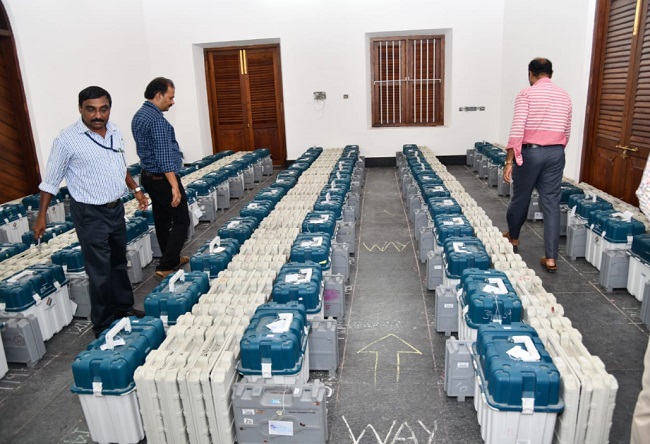New Delhi: Amid allegations that the Electronic Voting Machines (EVMs) used in the elections were being changed ahead of counting of votes Thursday, PRS Legislative Research, an independent research institute, explained Wednesday how the counting process takes place.
The polls to elect the 17th Lok Sabha were held in seven phases for 542 constituencies till May 19. The EVMs, over which questions are being raised lately, have been used for elections since 2000.
The Election Commission has conducted 113 Assembly elections and three general elections using EVMs.
VVPAT system, which generates a printer paper slip bearing the name and election symbol of the candidate voted for, was added to EVMs in 2013 to increase transparency and improve voter confidence in the system.
The Supreme Court instructed the EC April 8, 2019 that printed VVPAT slips from randomly selected five polling stations in each Assembly segment of a parliamentary constituency should be matched with EVMs.
Who is responsible for counting the votes?
The Returning Officer (RO) is responsible for conducting elections in a constituency, which also includes counting of votes. The RO is a government officer or a local authority nominated by the EC for each constituency.
Where does the counting take place?
The RO decides the place where the votes will be counted for the parliamentary constituency. The date and time of counting is fixed by the EC. Ideally, counting of votes for a constituency should be done at one place, preferably at the headquarters of the RO in that constituency.
It should be performed under the direct supervision of the RO. However, each parliamentary constituency has multiple Assembly segments. In this situation, counting can take place at different locations for various Assembly segments under the direct supervision of an Assistant Returning Officer (ARO).
Counting of votes for each Assembly segment of a parliamentary constituency is performed in a single hall. In each round of counting, votes from 14 EVMs are counted. In case of simultaneous parliamentary and Assembly elections, such as Odisha, the first seven tables are used for counting votes for Assembly elections, and the rest for parliamentary elections.
In constituencies with a large number of candidates, it may not be possible to count votes for all candidates in a single hall without overcrowding it. In such a situation, the number of counting halls or tables can be increased with the prior permission of the EC. A hall can be used for counting votes of another Assembly segment after the results of the first segment are declared. However, counting may be done for only one Assembly segment in a hall at any point of time.
The counting process
Counting is performed by supervisors appointed by the RO. Counting staff is appointed through a three stage randomisation process to ensure impartiality. Candidates along with their agents are also present in the counting hall.
Counting begins with Electronically Transmitted Postal Ballots and Postal Ballots (PB). These votes are counted under the direct supervision of the RO. Counting of EVMs can start 30 minutes after the commencement of PB counting, even if all PBs have not been counted. At the end of each round of counting, the results from 14 EVMs are declared.
Process for counting VVPAT slips
The EC prescribes the process for randomly selecting one EVM for each Assembly segment of a parliamentary constituency for VVPAT matching. The verification of VVPAT paper slips is conducted inside a secured VVPAT Counting Booth in the counting hall with access to authorised personnel only. Any counting table in the hall can be converted into VVPAT counting booth after completing EVM vote counting. Parliamentary constituencies generally have between five and 10 Assembly segments.
The Supreme Court has decided that VVPAT slips of five randomly selected polling stations for each Assembly segment shall be matched with the result shown in the respective EVMs. This implies that VVPAT paper slips need to be matched for about 25-50 machines for each parliamentary constituency. This process requires personal supervision of RO/ARO.

